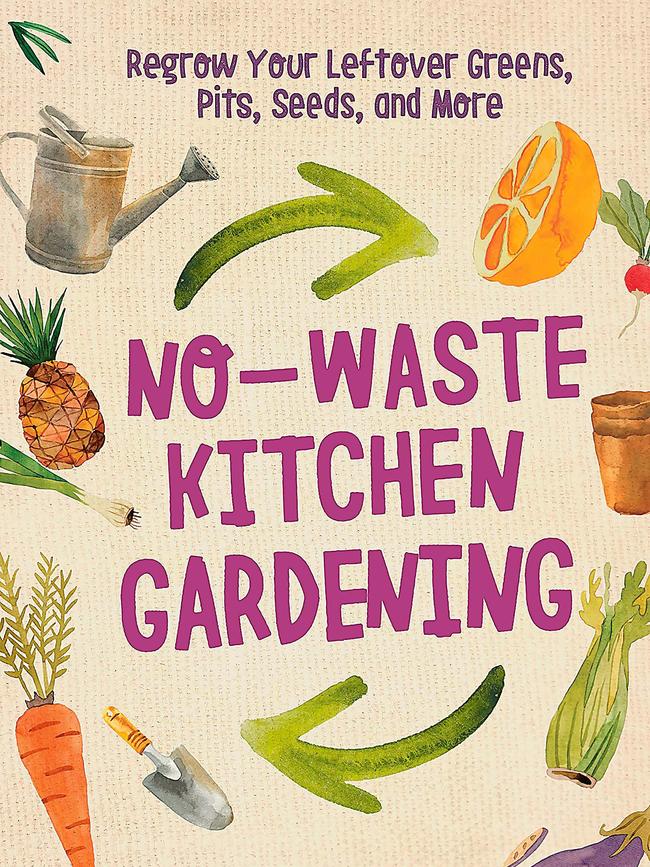Gardening books to put your feet up with
An August study by Amazon Australia found three in four millennials are keen gardeners.

A high proportion of Australians are engaged with gardens and younger people’s enthusiasm for indoor plants continues to flourish. An August study by Amazon Australia found three in four millennials are keen gardeners and nearly two-thirds of Australians are interested in growing organic food. For these enthusiasts, the latest gardening books make ideal Christmas gifts – though our annual review of new titles reveals that sadly, fewer have been published in 2019 than usual.


Among the gems are The Edible Garden Cookbook & Growing Guide by Paul West (Pan Macmillan, $40), which covers a range of homegrown produce. West, host of the TV series River Cottage Australia, includes composting, wicking beds, keeping chickens and bees, recipes and a section on community gardens.
No-Waste Kitchen Gardening by Katie Elzer-Peters (Murdoch Books $27) is all about using your kitchen scraps to grow more food. Why throw out the cut ends of carrots, radishes and spring onions when you can grow new plants from them? You can even regrow lettuce and celery in a glass of water. The fun presentation style of the book makes it appealing and there are clear photographs and instructions.
Titles that will make lovely gifts include The Gardener’s Travel Companion to England (Images Publishing, $50) by Australian journalist and photographer Janelle McCulloch. Part guidebook and part armchair delight for garden lovers, it has beautiful photographs as well as information on gardens to visit and garden-themed places to stay, dine and drink. Closer to home, Cranlana: The First 100 Years (Hardie Grant, $80) by Michael Shmith is the story of the original Myer family home and its extensive garden in Melbourne’s Toorak.
For space-challenged urban gardeners, Jason Chongue’s new book Green “simplifies how to curate and look after plants” in small spaces. The Instagram-leading stylist and co-owner of The Plant Society is inspirational when it comes to creating a plant-filled retreat, including offices, shops and entrances as well as homes, courtyards and balconies. Expect great pictures, tips and step-by-step instructions.
The Waterwise Australian Native Garden (Murdoch Books, $40) by Angus Stewart and A.B. Bishop is an updated, soft-cover version of their best-selling, award-winning book The Australian Native Garden, first published in 2015. In our drought-stricken country, the increased emphasis on waterwise practices, including how to create a fire-resistant garden, is timely. The photography is gorgeous and the section on garden-worthy cultivars of native plants is useful.
For bird lovers, there are two interesting new books. Bird Bonds by Gisela Kaplan (Pan Macmillan, $35) is an absorbing look at the emotional lives and mating habits of Australian native birds. Kaplan, emeritus professor in animal behaviour at the University of New England, explores questions such as why Australia has so many long-lived and long-bonding bird species. For those keen to attract wild birds, Feeding the Birds at Your Table by behavioural ecologist Darryl Jones (NewSouth, $25), provides science-based advice that will benefit both the birds and us. Happy reading.
Q&A
Is horse manure a useful fertiliser or is it just a soil conditioner? And can I use dog droppings in the garden? Mary Merlin, by email
Horse poo typically has levels below 2 per cent nitrogen, 1 per cent potassium and 0.3 per cent phosphorus, but it depends on the horse’s feed. It’s an excellent, bulky soil conditioner but often has grass or weed seeds that will sprout. Dog droppings can contain parasitic worm eggs and bacteria so although compostable, their use near edible plants is not recommended.
What small, evergreen shade trees could we plant in the 2m-wide bays of our soccer club’s car park that will survive in clay soils but not crack the bitumen? Judy Friguglietti, Monbulk, Vic
Yarra Ranges Shire Council’s website has a useful street tree directory, with fact sheets, that includes indigenous Eucalyptus cephalocarpa and natives such as bottlebrushes (Callistemon salignus and viminalis), Melaleuca linariifolia and water gum (Tristaniopsis laurina). A cultivar, ‘Luscious’, of this last has larger, glossier leaves. Dwarf gums to about 6m include Eucalyptus leucoxylon ‘Euky Dwarf’ and E. scoparia ‘Dromana’. Considering deciduous trees would widen your options.
The abandoned, potted frangipani I planted last year in a depleted bed has flourished and reached 1.5m. As expected, it lost its leaves in winter but why in early November doesn’t it have any new leaves? Judithann Carter, by email
Frangipanis often don’t leaf until November, and the cooler your climate, the later this will be. Be patient; if the stem tips are firm and green all will be well. Water and fertiliser will help fuel growth as the soil warms.
Send your questions to: helenyoungtwig@gmail.com or Helen Young, PO Box 3098, Willoughby North, NSW 2068. Website: helenyoung.com.au. The best question for December/January wins a Leatherman Free T4 with 12 tools, worth $140. November’s winner is Susan Munday of Melbourne for her question about vinegar flies.




To join the conversation, please log in. Don't have an account? Register
Join the conversation, you are commenting as Logout